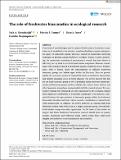Files in this item
The role of freshwater bioacoustics in ecological research
Item metadata
| dc.contributor.author | Greenhalgh, Jack A. | |
| dc.contributor.author | Genner, Martin J. | |
| dc.contributor.author | Jones, Gareth | |
| dc.contributor.author | Desjonquères, Camille | |
| dc.date.accessioned | 2021-03-24T17:30:01Z | |
| dc.date.available | 2021-03-24T17:30:01Z | |
| dc.date.issued | 2020-05-01 | |
| dc.identifier | 272933369 | |
| dc.identifier | b132975b-007a-43e3-958a-3b26bf0249f1 | |
| dc.identifier | 85094928050 | |
| dc.identifier.citation | Greenhalgh , J A , Genner , M J , Jones , G & Desjonquères , C 2020 , ' The role of freshwater bioacoustics in ecological research ' , Wiley Interdisciplinary Reviews: Water , vol. 7 , no. 3 , e1416 . https://doi.org/10.1002/wat2.1416 | en |
| dc.identifier.issn | 2049-1948 | |
| dc.identifier.other | ORCID: /0000-0002-6150-3264/work/89178817 | |
| dc.identifier.uri | https://hdl.handle.net/10023/21708 | |
| dc.description | Funding: J.G. was supported by a NERC GW4+ FRESH CDT PhD studentship (NE/R011524/1). C.D. was supported by a grant from the Ministerio de Economía, Industria y Competitividad (CGL2017-88764-R, MINECO/AEI/FEDER, Spain). | en |
| dc.description.abstract | Conventional methodologies used to estimate biodiversity in freshwater ecosystems can be nonselective and invasive, sometimes leading to capture and potential injury of vulnerable species. Therefore, interest in noninvasive surveying techniques is growing among freshwater ecologists. Passive acoustic monitor-ing, the noninvasive recording of environmental sounds, has been shown to effectively survey biota in terrestrial and marine ecosystems. However, knowl-edge of the sounds produced by freshwater species is relatively scarce. Further-more, little is known about the representation of different freshwater taxonomic groups and habitat types within the literature. Here we present results of a systematic review of research literature on freshwater bioacoustics and identify promising areas of future research. The review showed that fish are the focal taxonomic group in 44% of published studies and were studied pri-marily in laboratory aquaria and lotic habitats. By contrast, lentic habitats and other taxonomic groups have received relatively little research interest. It is par-ticularly striking that arthropods are only represented by 26% of studies, despite their significant contributions to freshwater soundscapes. This indicates a mis-match between the representation of taxonomic groups within the freshwater bioacoustic literature and their relative acoustic contribution to natural freshwater soundscapes. In addition, the review indicates an ongoing shift from behavioral studies, often with focus on a single taxonomic group, towards field-based studies using ecoacoustic approaches. On the basis of this review we suggest that future freshwater bioacoustics research should focus on passive acoustic monitoring and arthropod sound, which would likely yield novel insights into freshwater ecosystem function and condition. This article is categorized under: Water and Life > Nature of Freshwater Ecosystems Water and Life > Conservation, Management, and Awareness Water and Life > Methods. | |
| dc.format.extent | 20 | |
| dc.format.extent | 2504844 | |
| dc.language.iso | eng | |
| dc.relation.ispartof | Wiley Interdisciplinary Reviews: Water | en |
| dc.subject | Auditory ecology | en |
| dc.subject | Biodiversity | en |
| dc.subject | Ecoacoustics | en |
| dc.subject | Ecological assessment | en |
| dc.subject | QH301 Biology | en |
| dc.subject | Aquatic Science | en |
| dc.subject | Oceanography | en |
| dc.subject | Ocean Engineering | en |
| dc.subject | Ecology | en |
| dc.subject | Management, Monitoring, Policy and Law | en |
| dc.subject | Water Science and Technology | en |
| dc.subject | T-NDAS | en |
| dc.subject | SDG 14 - Life Below Water | en |
| dc.subject | SDG 15 - Life on Land | en |
| dc.subject.lcc | QH301 | en |
| dc.title | The role of freshwater bioacoustics in ecological research | en |
| dc.type | Journal article | en |
| dc.contributor.institution | University of St Andrews. School of Biology | en |
| dc.identifier.doi | https://doi.org/10.1002/wat2.1416 | |
| dc.description.status | Peer reviewed | en |
This item appears in the following Collection(s)
Items in the St Andrews Research Repository are protected by copyright, with all rights reserved, unless otherwise indicated.

